Rotation Stage with Resonant Piezoelectric Motors
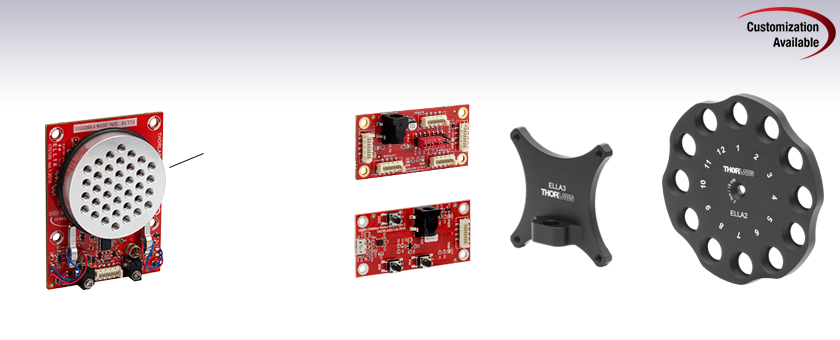
- Ø50 mm Rotation Stage with Closed-Loop Positioning
- Open Frame Design for OEM Applications
- Control via Interface Board, GUI, or ASCII Message Calls
- SM05-Threaded Filter Wheel Accessory Available
ELLA3
Post Mount Adapter
ELL18K
Rotation Stage Bundle
(Stage and Board Included)
8-32 Tapped Holes
(M4 for ELL18K/M)
37 Places
Rotation Stage
(Also Available Individually)
Interface Board
ELLB
Bus Distributor
ELLA2
Filter Wheel Adapter

Please Wait
| ELL18(/M) Key Specifications a | ||
|---|---|---|
| Travel (No Limit Switches) b | 360° Continuous | |
| Homing Repeatability | 1.75 mrad (0.1°) | |
| Bidirectional Repeatability | 873 µrad (0.05°) | |
| Velocity (Maximum) | 430 °/s | |
| Maximum Total Load | 200 g (7.05 oz) c | |
| DC Voltage Input | 4.5 to 5.5 V | |
| Weight of Stage and Brackets | 90 g (3.17 oz) | |
| Minimum Lifetime | 100 km (600 600 Revolutions) | |
| Stage Dimensions (Without Brackets) |
81.0 mm x 60.0 mm x 20.3 mm (3.19" x 2.36" x 0.80") |
|
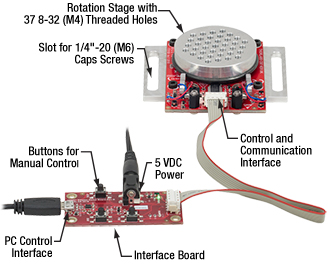
Click to Enlarge
The components of the ELL18K Rotation Stage bundle are shown connected and with key features labeled.
Features
- Ideal for OEMs and Applications Requiring Rapid and Precise Positioning
- Micro-B USB and Picoflex ®1 Connectors for Control Signals
- Multi-Drop Serial Communication Protocol Supported
- Ø50.0 mm (Ø1.97") Rotation Stage
- Absolute Home Position Found with Infrared and Magnetic Sensor Technologies
- Magnetic Encoder Used to Position Stage
- Optional Accessories Offered Below
- ELLA2 Filter Wheel Adapter with 12 SM05-Threaded (0.535"-40) Holes
- ELLA3 Post Mount Adapter for Mounting the Rotation Stage Upright
- Bus Distributor to Facilitate Control of up to Four Elliptec ® Devices
- ELLC2 Accessory Upgrade Pack
Driven by Thorlabs' Elliptec piezoelectric resonant motor technology, this rotation stage is designed to be a compact solution for applications requiring rotational control. The rotation stage is offered as a standalone unit (Item #'s ELL18 and ELL18/M), or as part of a bundle (Item #'s ELL18K and ELL18K/M), which also contains an interface board for manual control of the stage, mounting brackets, power supply, and cables for connecting the stage and interface board to each other and to a PC. Thorlabs also offers the ELLC2 Accessory Pack which can be used to upgrade standalone units to kits. Please note that the ELLC2 Accessory Pack does not include the brackets used in the ELL18K(/M) bundle.
Each stage has 37 8-32 (M4) tapped holes on 0.25" (6.4 mm) centers providing flexible mounting options. The rotation stage is lightweight and compact, and the closed-loop operation provides rotation to specified orientations with a repeatability of 873 µrad. The assembled components of the ELL18K(/M) are shown in the image to the far right, with key features labeled. Please see The Elliptec ® Motor tab for more information.
The rotation stage can be mounted horizontally using the mounting brackets included in the ELL18K(/M) bundle or upright using the ELLA3 Post Mount Adapter (sold separately). The ELLA2 Filter Wheel Adapter, sold separately and shown in the image to the bottom right, can be mounted on the ELL18(/M) rotation stage and has 12 SM05-threaded holes for holding filters. For applications requiring switching between Ø1" filters, or with vertical space constraints, Thorlabs offers a variety of multi-position sliders driven by Elliptec motors.
The motor is highly dynamic and has no gearing. The tips of both motor housings are in firm contact with the plastic track at the base of stage, as can be seen in the image at the right. The motors are installed with opposite orientations, and translation in both directions occurs when one motor pushes the track forward while the other pulls it backward. The rotation stage is not designed for continuous operation. We recommend operation with duty cycles of 40% or less. When power is not applied to the motors, the stage is held in place by an approximately 0.025 N·m combined torque exerted by the stationary arms of the motors.
The open frame format, versatility, and simplicity of this rotation stage makes it attractive for OEM applications, as it can be customized according to customer requirements and produced in high-volume quantities. Please contact us to discuss your specific requirements so that we may tailor a solution to meet the needs of your application.
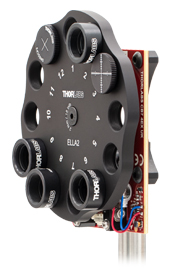
Click to Enlarge
Assembled View
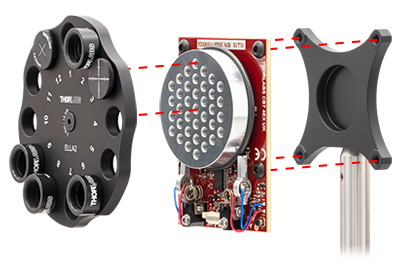
Click to Enlarge
Exploded View
Control
There are multiple options for powering, driving, and controlling this rotation stage, which are detailed in the Positioning the Rotation Stage section of the Operation tab. The stage possesses a 3.3 V serial bus and is designed to be operated with or without the interface board; the Pin Diagram tab provides pin assignments. Thorlabs offers software for our Elliptec products capable of providing full and independent control of the stage. When the interface board is used as an accessory to change the position of the stage, its status in the software is automatically updated.
Multiple Elliptec devices can be controlled using the ELLB Bus Distributor or by splicing multiple connectors onto one ribbon cable. A single bus distributor can connect up to four Elliptec devices; up to 16 devices can be connected if the buses are daisy chained. This bus can be controlled one of three ways: through an interface board (included with the bundles below) to connect to a PC running the Elliptec software, by connecting to an Arduino ®2 or Raspberry Pi ®3 board, or by wiring the connector pins to a user-supplied control board. Alternatively, up to 16 devices can be spliced onto a single ribbon cord. The devices can then be simultaneously controlled by the interface board or selectively controlled by the Elliptec software. See the manual for instruction on how to splice multiple devices onto a ribbon cord and the Pin Diagrams tab for pin assignments when making custom connections.
- Picoflex is a registered trademark of Molex Incorporated.
- Arduino is a registered trademark of Arduino Sa Société Anonym (SA).
- Raspberry Pi is a registered trademark of the Raspberry Pi Foundation.
| Elliptec Resonant Motor Products | |||||
|---|---|---|---|---|---|
 |
 |
 |
 |
 |
 |
| Multi-Position Sliders |
28 mm Linear Stage |
60 mm Linear Stage |
Rotation Stage | Rotation Mount |
Motorized Iris |
| Specificationsa | |
|---|---|
| Performance | |
| Travel | 360° Continuousb |
| Maximum Speedc | 430 °/s |
| Bidirectional Repeatabilityd | 873 µrad (0.05°) |
| Homing Repeatabilityd | 1.75 mrad (0.1°) |
| Bidirectional Accuracye | 6.98 mrad (0.4°) |
| Backlash | 226.9 µrad (0.013°) |
| Encoder Resolution (Relative Magnetic Encoder) | 143360 counts/rev (43.8 µrad/count) (0.0025°/count) |
| Minimum Incremental Motion | 34.9 µrad (0.002°) |
| Minimum Holding Torque (Both Motors Engaged) | 0.015 N•m |
| Axis Wobblef | 331.6 µrad (0.019°) |
| Maximum Total Loadg | 0.200 kg (0.441 lbs) |
| Minimum Lifetimeh | 600 600 Revolutionsi (100 km) |
| Electrical | |
| Motor Type | Elliptec® Resonant Piezo |
| DC Voltage Input | 4.5 to 5.5 V |
| Typical Current Consumption, During Movement | 800 mA |
| Typical Current Consumption, During Standby | 50 mA |
| Communications | |
| Bus | Multi-Drop 3.3 V/5 V TTL RS232 |
| Connector on Rotation Stage Board | Picoflex® |
| Connectors on Interface Board | Picoflex®, Micro USB, Power Supply |
| Speed | 9600 baud |
| Data Length (1 Stop Bit, No Parity) | 8 bit |
| Protocol Data Format | ASCII HEX |
| Module Address and Command Format | Mnemonic Character |
| Mechanical | |
| Mounting Threads (On Stage, 37 Places) | 8-32 (M4 x 0.7) Length: 0.24" (6.0 mm) |
| Dimensions of the Rotation Stage Board (Without Mounting Brackets) |
81.0 mm x 60.0 mm x 20.3 mm (3.19" x 2.36" x 0.80") |
| Weight of Rotation Stage Board | 90 g (3.17 oz) |
| Environmental Operating Conditions | |
| Temperature Range | 15 to 40 °C (59 to 104 °F) |
| Maximum Relative Humidity (Non-Condensing) | <80% at 31 °C |
| Maximum Altitude | 2000 m |
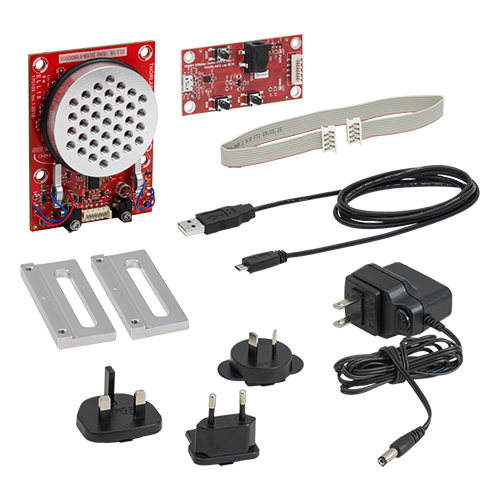
Click to Enlarge
Components of the ELL18K(/M) Bundle
(One Region-Specific Power Adapter Included with the Power Supply)
As shown in the image above, two mounting brackets are included with the bundle. The brackets fastens to the underside of the rotation stage's PCB with the four included screws. Each bracket features a slot for 1/4"-20 (M6) cap screws to secure the stage board to optical tables and breadboards. The bracket adds 0.05" (1.2 mm) of thickness to the profile of the stage.
The drawing below shows the dimensions and mounting features of the stage itself. The spacing and threading of the 37 mounting holes in the stage differs between the imperial (ELL18) and metric (ELL18/M) versions of the stage. All other dimensions, including the 1.97" (50.0 mm) diameter of the stage are the same for both.
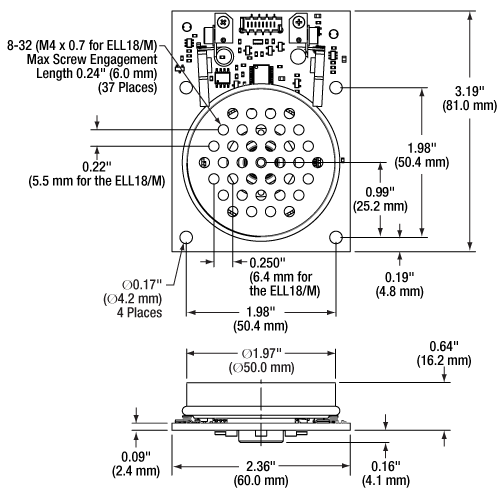
Click to Enlarge
Mechanical Drawing of the Rotation Stage
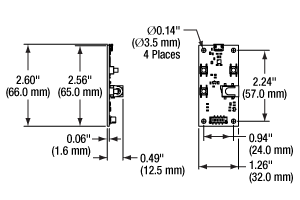
Click to Enlarge
Mechanical Drawing of the Interface Board
| Connector J1 Pinouta | ||
|---|---|---|
| Pin | Type | Function |
| 1 | PWR | Ground |
| 2 | OUT | OTDX - Open Drain Transmit 3.3 V TTL RS232 |
| 3 | IN | RX Receive - 3.3 V TTL RS232 |
| 4 | OUT | In Motion, Open Drain Active Low Max 5 mA |
| 5 | IN | JOG/Mode, Active Low Max 5 V |
| 6 | IN | BW Backward, Active Low Max 5 V |
| 7 | IN | FW Forward, Active Low Max 5 V |
| 8 | PWR | VCC +5 V ±10%; 800 mA |
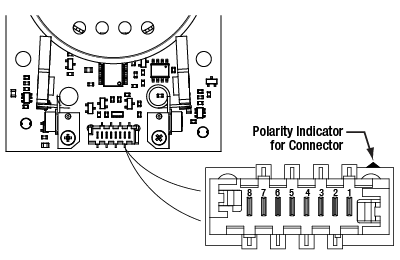
Click to Enlarge
Pinout diagram of the Picoflex® connector is shown referended to a partial diagram
of the ELL18(/M) Rotation Stage Board.
| ELLB Connector J1, J2, J3, and J4 Pinouta,b | ||
|---|---|---|
| Pin | Type | Function |
| 1 | PWR | Ground |
| 2 | OUT | OTDX - Open Drain Transmit 3.3 V TTL RS232 |
| 3 | IN | RX Receive 3.3 V TTL RS232 |
| 4 | OUT | In Motion, Open Drain Active Low Max 5 mA |
| 5 | IN | Not Connected |
| 6 | IN | Not Connected |
| 7 | IN | Not Connected |
| 8 | PWR | VCC +5 V ± 10%; 800 mA per Connected Device |
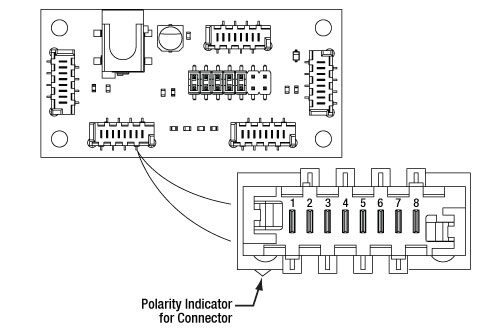
Click to Enlarge
Pinout diagram of the Picoflex® connector is shown referenced to a simplified diagram
of the ELLB Bus Distributor. The polarity indicator on the connector
must be adjacent to the red wire on the supplied 8-connector cables.
Operation Notes
This tab contains information on handling, mounting, and operating the ELL18K(/M) Rotation Stage Bundle.
Contents- Handling
- Mounting and Loading the Rotation Stage
- Supplying Power
- Operation of the Motors
- Homing the Rotation Stage
- Positioning the Rotation Stage
- Resonance Frequencies
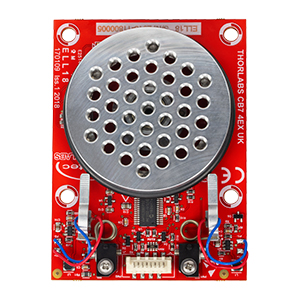
Click to Enlarge
The Rotation Stage
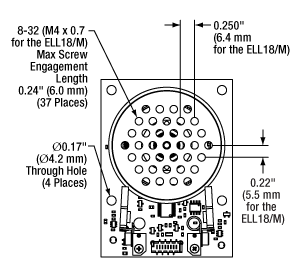
Click to Enlarge
Features of the Rotation Stage
Handling
The rotation stage and interface board included in the ELL18K(/M) bundle are robust to general handling. To ensure reliable operation, keep the surface of the plastic track contacted by the motors free of oils, dirt, and dust. It is not necessary to wear gloves while handling the rotation stage, but avoid touching the track to keep it free of oils from fingerprints. If it is necessary to clean the track, it may be wiped with isopropyl alcohol or mineral spirits (white spirit). Do not use acetone, as this solvent will damage the plastic track.
The open frame format of the ELL18(/M) rotation stage can tolerate up to 8 kV of static discharge. ESD precautions should be taken, as an electrostatic discharge can produce an electrical signal that may cause an unintended movement of the stage. A bending load in excess of 500 g applied to the board may cause the PCB to deform, which will degrade the performance of the rotation stage. As readings from a magnetic sensor are used during the homing and positioning of the stage, avoid subjecting the structural PCB to excessive loads or magnetic fields. Limit the strength of magnetic fields in proximity to the magnetic sensor to ±5 mT to avoid negatively affecting the homing and positioning operations.
Mounting and Loading the Rotation Stage
The rotation stage can be mounted so the top surface of the stage is either in the horizontal or the vertical plane. There are four Ø4.2 mm (Ø0.17") through holes located along the edges of the board, which are visible in the image at the center-right of this tab, that may be used to mount the stage. For mounting the stage horizontally, the ELL18K(/M) rotation stage comes with two mounting brackets with slots for 1/4" (M6) screws. The rotation stage can be mounted to the brackets with the four included M3 screws. For vertical mounting, attach the rotation stage to the ELLA3 post mount adapter with the included four M4 screws. When mounting the stage, ensure that the installation does not bend the PCB.
Loads may be mounted to the stage using the 37 tapped holes for 8-32 (M4) threaded screws, whose spacing is shown in the diagram to the right. The maximum allowed weight of the mounted components is 200 g. The mounted load must be centered on the stage in order to achieve 200 g. In all cases of mounting and loading, ensure that nothing interferes with the moving parts of the rotation stage and that the stage and its load are securely fastened to prevent jostling during movement. Jostling of the stage or the load can cause an encoder error.
Supplying Power
When the setup includes the interface board, power may be supplied through the Micro-B USB connector and/or the 5 VDC power socket located on the board. The electronics on the interface board convert the applied DC signal to a sinusoidal signal oscillating at the required resonance frequency.
The ELL18K(/M) bundle includes a 5 VDC power supply whose connector mates with the power socket on the interface board. Delivering power through this socket also allows the Micro-B USB connector to be used for a computer to control the stage remotely. The power supplied by a computer through the USB 2.0 connection is not sufficient to power the stage. If computer control is not necessary, another option for supplying power to the stage is a portable USB 5 V battery pack connected to the Micro-B USB connector on the interface board.
When the implementation does not include the interface board, the connection with the power source is made using the pins on the Picoflex® connector that is included on the rotation stage board. A pinout diagram of this connector is included in the Pin Diagram tab, and information on powering and addressing the rotation stage is given in the manual and the communications protocol manual, respectively.
Operation of the Motors
The motion of the rotation stage is controlled by forcing the piezoelectric elements to vibrate at specific ultrasonic frequencies. For each motor, there is one ultrasonic resonant frequency that will push the stage forward, and another that will pull the stage backward. Operating a motor at one of its resonance frequencies causes the tip of the motor to continuously cycle in a tight clockwise elliptical path. When the motor is driven at its other resonant frequency, the tip of the motor cycles through that same path in a counterclockwise direction. Both resonant frequencies are around 100 kHz. The total displacement at the tip of motor is a function of the mechanical load it is driving and the voltage supplied to the piezo element. In the case of no loading and a 5 V maximum driving voltage at a resonant frequency, the tip of the motor expands and contracts no more than a few microns while tracing the elliptical path. Please see The Elliptec® Motor tab for more information and an animation illustrating the operational principle of the motors.
Homing the Rotation Stage
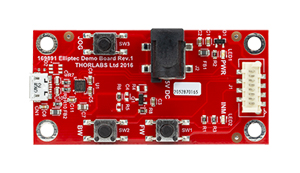
Click to Enlarge
The Interface Board
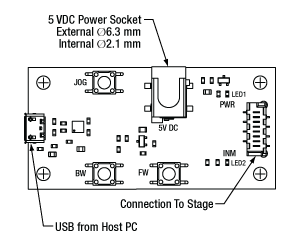
Click to Enlarge
Features of the Interface Board
To Home the stage, press the BW button on the interface board, click the Home button in the Elliptec software's graphical user interface (GUI) or send the appropriate ASCII message as is specified in the communications protocol manual.
The default Home position is referenced to a fixed feature on the stage assembly. If desired, the user may redefine the position of Home to be offset from the default position by up to +90° (a quarter turn in the clockwise direction). Being able to customize the Home position can be useful when synchronizing the orientations of two or more stages. When executing the Home command, the stage first finds the approximate location of Home, and then a fine-positioning procedure is used to orient the stage at Home with an accuracy of 288.0 µrad. The user can specify whether the stage rotates in a clockwise or counterclockwise direction (as defined from the perspective of looking down on the surface of the stage) during the first phase of the homing procedure, but the fine-positioning phase is always performed in the counterclockwise direction for repeatability.
Positioning the Rotation Stage
Note that the rotation stage is not intended for continuous operation. We recommend operation with duty cycles of less than 40% during general use, while operation with duty cycles greater than 60% should be limited to a few seconds.
Before the stage may be positioned, the Home position of the stage must be found. Please see the previous section for details. The movement of the stage may be controlled through computer control via the Elliptec® software package that may be downloaded, or by sending simple signals to digital lines on the stage's board. A link to download the software and accompanying documentation can be found in the Software tab.
Multiple Elliptec devices can be be controlled using the ELLB Bus Distributor or by splicing multiple connectors onto one ribbon cable. A single bus distributor can connect up to four Elliptec devices; up to 16 devices can be connected if the buses are daisy chained. This bus can be controlled one of three ways: through an interface board (included with the bundles below) to connect to a PC running the Elliptec software, by connecting to an Arduino® or Raspberry Pi® board, or by wiring the connector pins to a user-supplied control board. Note that if an interface board is used, its on-unit buttons will be disabled. Alternatively, up to 16 devices can be spliced onto a single ribbon cord. The devices can then be simultaneously controlled by the interface board or selectively controlled by the Elliptec software. See the manual for instruction on how to splice multiple devices onto a ribbon cord and the Pin Diagrams tab for pin assignments when making custom connections. The communications protocol manual describes how to use the software to individually address each connected device. IA link to download the software and accompanying documentation can be found in the Software tab.
The default increment to move the stage forward and backward is 45°, and a custom increment can be set using the Elliptec software or by sending the appropriate ASCII message(s) as specified in the communications protocol manual. The Elliptec software can be used to move the stage to absolute and relative positions, in addition to jogging the stage forward or backward. The software is also used to set the jog step size, read the position of the stage, and adjust the position of Home, as is described in the previous section.
Readings from the magnetic sensor, which can resolve angular increments of 24.0 µrad, are used to position the stage and when executing the Home command. The travel range of the stage is not limited, but the reported orientation of the stage is always expressed as a value between 0° and 359.99°. The minimum incremental movement of the stage is 288.0 µrad, and it can be positioned with a repeatability of 434 µrad in response to signals from the magnetic sensor.
The stage learns to efficiently position itself precisely using a position error compensation algorithm. After the stage moves into a new position, it detects the error between the requested and actual positions. The position of the stage is then corrected, and an error compensation value is calculated. The algorithm is then updated with the error compensation value, so that it is applied when the stage is move to its next position. Typically, an optimum error compensation value is found after between two and six movements.
Resonance Frequencies
On power-up, the factory default setting instructs each motor driving the rotation stage to search for the resonance frequencies that will deliver the best performance. During this process, the rotation stage will translate a forward and backward by a small amount. If movement on start-up is undesirable, it is possible to disable this calibration procedure by using the serial port to initialize the frequencies on power-up. A new search for optimal resonance frequencies may be performed at any time; to maintain optimal performance, it is recommended that new searches be performed after changes in loading and/or ambient temperature. Please see the manual for details.
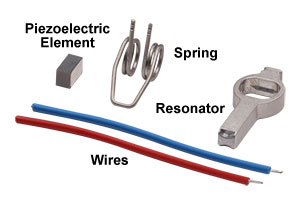
Click to Enlarge
The Components of the Elliptec Motor
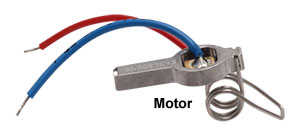
Click to Enlarge
The Elliptec Piezoelectric Resonant Motor
The Elliptec® Piezoelectric Resonant Motor
Thorlabs' Elliptec® piezo resonant motor, shown at right, is lightweight, with a mass of 1.2 g, and compact: the dimensions of the resonator housing, excluding the spring, are 8 mm x 4 mm x 20 mm.
Components of the Motor
The components that compose the motor are shown at far-right. The piezoelectric element is press fit into the aluminum resonator, which has been precisely designed and machined to produce the desired elliptical motion at the tip and to interface optimally with the driven module. The free ends of the spring are integrated with the resonator housing. The wires, which are soldered to the top and bottom of the piezoelectric element, deliver the voltage signal that induces the piezoelectric element to vibrate at ultrasonic frequencies.
When the motor is built into a system, the open loop of the spring is bolted to a sturdy surface that is stationary with respect to the item to be driven, and the tip of the resonator is placed in contact with the item. The purpose of the spring is to maintain constant contact between the tip of the resonator and the driven item, and the direction of motion is determined by the resonance frequency at which the piezo element is driven.
Elliptical Motion and Comparison with Conventional Motors
The motor is operated by driving it at one of its two resonance frequencies. A voltage signal oscillating at an ultrasonic frequency is applied to the piezoelectric chip, which responds by expanding less than a micron and then contracting back to its original dimensions at the frequency of the driving signal. This rapid-cycling change in the chip's dimensions causes a vibration in the aluminum resonator housing. When the vibration is at one of the housing's resonance frequencies, a pushing motion results at the tip of the motor. When the vibration is at the other resonance frequency a pulling motion results.
As illustrated in the video, the pulling and pushing motions result from the tip of the motor tracing an elliptical path in space when the motor operates at resonance. The selected resonance frequency controls the direction of the cyclical motion. The motor's tip traces one half of the ellipse as it expands and the other half as it contracts. When the motor pushes the driven item, the motor's tip is in contact with the item while the tip expands; the two are not in contact while the tip contracts. The converse is true when the motor pulls the driven item in the opposite direction. The total displacement at the tip of the motor is a function of both the mechanical load it is driving and the voltage supplied to the piezo element. The maximum displacement can be up to a few microns when the peak driving voltage is 5 V.
The motor behaves in many ways like a DC or electromagnetic stepper motor, but it does not suffer from many of the drawbacks of these conventional motors. Unlike conventional electromagnetic motors, which must overcome inertial delays to come to a stop, the highly dynamic Elliptec motor can stop within microseconds. As it has no gears, it does not exhibit backlash. Since it possesses no magnets, it is compatible with use in environments sensitive to electromagnetic interference. The motion of the driven element is continuous and smooth. As the tip of the motor must be in contact with the driven item to induce motion, the motor possesses the safety feature of an inherent friction brake. When in contact with a plastic surface, the motor operates virtually silently.
For OEM applications, the motor can be manufactured in volume at low cost, and it can be driven by inexpensive analog electronics. It does not require microprocessors or software; however it is compatible for use with them.
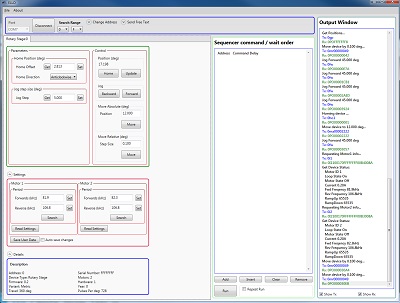
Click to Enlarge
The Elliptec Piezoelectric Resonant Motor Control Software GUI
Software for Devices Driven by Elliptec® Piezoelectric Resonant Motors
All devices based on the Elliptec® resonant piezo motor may be controlled by the Elliptec system software, which features an intuitive graphical user interface (GUI). The source code, in C# format, is included in software bundle available for download, and custom applications can be created in any language. The image at right shows a screen capture of the GUI, and the button that follows links to the download page.
Commands are entered in the Sequencer command / wait order section located at the center-left of the GUI. An example of a sequence of commands that might be sent to the device is "Aho0" to move to the rotation stage at address "A" to the home position in the clockwise direction, and then "Afw" to move the stage at address "A" forward by the jog increment. The command "As1" is used to perform the frequency search that will identify the optimal resonant frequencies, for the current operating conditions, for Motor 1 at adddress "A."
| Posted Comments: | |
user
(posted 2024-06-20 11:43:11.07) Can we control with LabVIew?
Thanks do'neill
(posted 2024-06-21 09:25:18.0) These can be controlled in LabVIEW, I will reach out to you directly with an example VI. user
(posted 2023-11-30 14:46:41.31) Inquiry Regarding Discrepancy Between Serial Port Voltage Specification and Actual Output for ELL18 Motor:
Dear Thorlabs Support Team,
As a user of your product, specifically the ELL18 motor, I have recently encountered a concerning issue regarding the serial port of this device. According to the product manual, the TX pin of the serial port is supposed to output 3.3V. However, upon measurement, I have observed that it is actually outputting close to 5V.
This discrepancy could potentially impact the safety and compatibility of the product, especially when connected to other electronic components designed for 3.3V. I believe this matter requires your attention and action.
(Note: This email was translated using a translation tool.) Andy von Flotow
(posted 2023-11-05 09:20:13.993) I hope to add 2 or more elliptec motor elements to a rotary stage, with 3rd-party encoder and drive electronics.
Please advise:
Models and availability of the elliptec resonator/spring assembly. Probably exactly as-produced in Dortmund
Variability of the two resonant frequencies used to drive forward/backward (must my logic adaptively identify these frequencies?)
Best way for me to become informed? Buy your cute little rotary stage and driver board; learn from it? The “bundle:” ELL18K
I look forward to this project. do'neill
(posted 2023-11-14 10:15:38.0) Response from Daniel at Thorlabs. II will reach out to you directly to discuss your needs and your questions. Vincent Mall
(posted 2023-09-19 15:00:07.267) Hi, I inted to use the ELL18 Stage in a vertical setup for aiming rays over different elevations. However, I could not find any load data for shear force or motor torque. Could you supply me with that?
Kind regards! do'neill
(posted 2023-09-22 09:35:48.0) Response from Daniel at Thorlabs. I will reach out to you directly as this can be very application dependent and depend on the positioning of the load. Nimmy Jose
(posted 2023-04-11 18:41:08.337) Can I use labview to control this motor? Do you have sample code for a beginner? JReeder
(posted 2023-04-12 03:15:11.0) Thank you for your enquiry. I have reached out to you directly to provide an example LabVIEW VI for this product. Konstantin Glazyrin
(posted 2023-03-02 09:21:26.577) Hi! The stage seem to rotate only 3 full turns as tested jogging of 360 degrees and one cannot make it in one single operation. According to the what we understand of the operation principle, the stage potentially can be used for continuous rotation, but this feature may require a change of microcontroller firmwire? Daria Bezshlyakh
(posted 2022-08-29 13:19:04.613) Hi. How well does the stage perform in operation in cycles? E.g. turn 50° back and forth 500 times with a duty cycle 40% or less? Thank you! cwright
(posted 2022-08-30 06:29:19.0) Response from Charles at Thorlabs: Thank you for your query. To answer this we would need to know which specifications you are interested in to assess the performance. I will reach out to you to discuss this and what we can provide. Victor Lorenz Fonfria
(posted 2022-05-17 11:26:42.087) I am interested in buying an additional interface board for ELL18, but just the interface, not the complete ELL18K set. Would that be possible? cwright
(posted 2022-05-17 09:25:01.0) Response from Charles at Thorlabs: Thank you for your query. Many component items can be requested directly from your local technical support team: https://www.thorlabs.com/supportcontact.cfm. We can provide this interface board and will reach out to you about your request. user
(posted 2022-04-01 08:33:52.523) Hey,
I would like to know if it's possible to get a continuous rotation with your product. For our application we only take a look about the rotation speed and no the position.
Your faithfully,
Julien cwright
(posted 2022-04-01 08:59:08.0) Response from Charles at Thorlabs: Thank you contacting us. This stage is not designed for continuous operation or precise velocity control. They are for accurate, quick positioning. We will reach out to you to discuss your application in more detail and come to a suitable solution. Daniel Heinrich
(posted 2021-10-26 16:00:31.56) Are you abel to make and quote custom brackets that would allow mounting the ELL18 on or rather bellow two rods of your 60mm cage system? The rotating platform fits perfectly between those two rods.
My application is to mount a tunable optical filter (tuning by rotating it) onto the rotation stage and add that to an existing 60mm cage. However, I need at least ~15mm space between the rotation platform and the optical axis. YLohia
(posted 2021-12-23 11:06:54.0) Hello, custom items can be requested by clicking on the "Request Quote" button above or by emailing techsales@thorlabs.com. We have reached out to you directly to discuss the possibility of offering this. Christoph Steffen Keppler
(posted 2020-05-12 06:33:16.48) Is it possible to control the Stage from within matlab? DJayasuriya
(posted 2020-05-12 10:35:18.0) Thank you for your question. Unlike Kinesis compatible devices, our Elliptec devices are controlled solely through serial commands (directly or through our Elliptec System Software). You should be able to configure MatLab to communicate through these serial commands however. You can find the serial communications protocol on the Elliptec software webpage. Jason Wong
(posted 2020-04-24 10:50:27.79) Can the ell be compiled through c or c++ to control the motor? Also can I import new libraries or new protocols through notepad into the motor? DJayasuriya
(posted 2020-05-01 09:43:25.0) Thank you for your feedback. Yes ELL can be complied through C or C++ please see the ELL communication Protocol. Unfortunately you wont be able to import new libraries or new protocols through notepad into the motor. Jonathan Cheung
(posted 2020-04-04 12:00:20.37) Could I have a example for using C++ to control the motor ?
I am not sure how to use protocol to control the motor, so would you give me a example how the protocols were used to control the motor.
Thank you so much. DJayasuriya
(posted 2020-04-07 05:25:18.0) Response from Dinuka at Thorlabs: Thank you for your inquiry. I will be in direct contact with you to help with your request. Kong Cheung
(posted 2020-01-28 14:26:26.143) Dear Thorlabs,
If I use write a program to control the motor by python via a PC USB connection, dose it mean i need to send code to the motor. As a result, it will run at what it should like?
Thanks! cwright
(posted 2020-01-30 04:30:44.0) Response from Charles at Thorlabs: Hello Kong,
If you want to use Python to communicate with the Elliptec stages via the USB interface board then you will either need to use a Python compiler which is compatible with our .NET ELLO_DLL which is written in C#, such as IronPython, or send serial commands to the stage via the interface board. The latter can also be accomplished with Python using pySerial.
Unfortunately we can not officially support Python but I will reach out to you directly to ensure I have understood your question and to see how we may support you further. kong Cheung
(posted 2019-11-06 22:33:26.727) Can I use python or labview to control this motor?
Do you have sample code for a beginner? cwright
(posted 2019-11-08 03:59:52.0) Response from Charles at Thorlabs: Thanks for your query. It is possible to interface through LabVIEW using the Thorlabs.Elliptec.ELLO_DLL.dll .NET assembly. This can be found in the Elliptec installation directory and I will send you an example we have. You can also use .NET assemblies through Python using the clr module but we do not have an example for this. user
(posted 2019-05-23 12:46:40.18) Could you give a bit more detail about the networked operation of two stages from a single USB port? Do I need two interface boards? Exactly how should I daisy-chain things together in this scenario?
Could you also explain what practical consequence having a larger value for bi-directional accuracy than repeatability means? If we are looking to calibrate something as a function of the angle read by the stage, am I right to assume that it is the repeatability that matters rather than accuracy? rmiron
(posted 2019-05-24 11:22:40.0) Response from Radu at Thorlabs: You can control up to 16 daisy-chained Elliptec stages (of various types) via a single interface board. I will contact you directly in order to send you a guide for how to make a custom daisy-chaining cable. Every different stage connected to the interface will have a different address byte, with values ranging from 0 to F. You can identify the address byte of a particular stage either from our ELLO software or by trial and error (sending a serial command and checking whether any stage responds).
Accuracy refers to the difference between the settled position after a move and the true position. Repeatability refers to the possible variation in settled positions when the same position is demanded multiple times in a single session. The former is much larger because it includes the homing accuracy. Because the travel is encoded, most of the inaccuracy comes from homing. After homing, the encoder doesn't allow the positional error to keep building up to large values. However, because it assumes the position at which the stage homed to be the true 0 position, the accuracy of the stage's moves will always include that homing accuracy. victor.lorenz
(posted 2018-09-21 14:13:30.68) By mistake I recently ordered the ELL8/M instead of the ELL8K/M (sales order MS3309025).
.
I wonder if I could order separately the missing Interface Board, Power Supply, Brackets and Cables. If so, how should I proceed when I made my new order to add these items?
If this is not the place for such request, who should I contact? rmiron
(posted 2018-09-24 06:45:18.0) Response from Radu at Thorlabs: Hello Victor. There is no need to worry about this. We will send you a quotation for the missing parts. The total price for them will equal the price difference between ELL8K/M & ELL8/M. user
(posted 2018-08-13 17:03:42.67) Hi, I'm trying to use an ELL8M for a scanning application where scanning time is key. Therefore I'd like to avoid stepped acquisition. Is it possible to stream out the encoder data during a continuous rotational movement? rmiron
(posted 2018-08-16 11:34:00.0) Response from Radu at Thorlabs: Unfortunately, this is not possible. The stage does not have any pins that are relaying the encoder's signal. With that being said, it would be a good idea to add one and I'll advertise your idea internally. The possibility to read the encoder pulses directly would greatly increase the Elliptec stages' suitability in fast scanning applications. b.kettle
(posted 2018-01-19 16:49:03.943) Hello, I recently purchased two Elliptec rotation stages; the ELL8K/M bundles. However I am having trouble getting both to run in tandem, or networked. I can't seem to find much information in the supplied manuals. I can successfully connect both stages to my PC using the separate control boards and usb cables, however these interface using two different COM ports, which the software doesn't accommodate. The manual does mention in this process to connect the second stage to the first stage, however mechanically there seems like no connections supplied to do this task. The stage PCB only has one connector, which runs to the one connector on the drive board, which has the usb straight to the computer. No means of linking them together. Can you please offer any advice on the situation? I like how the motors operate, but need to be able to control both stages from the one software window (and hence one set of sequences). Thank you in advance for any help. bwood
(posted 2018-01-22 09:02:14.0) Response from Ben at Thorlabs: Thank you for your feedback. You can operate up to 16 Elliptec devices at the same time, by daisy chaining the control boards together. In this setup, all of the devices are connected through one USB port. To do this you will need to create a custom cable, with several connectors installed along its length. The cable standard we use is the Molex Picoflex series with PF-50 sockets, we can suggest Farnell as a good local supplier of parts to do this. gpu
(posted 2017-10-04 14:38:21.78) Hi,
I bought such a stage but was'nt careful during the setup and crashed it against a breadboard. For some reason, this damaged the elastomer track and 3 mm are now indented such that the motors can't reach it. Is it possible to get the track as a spare part? bwood
(posted 2017-10-17 05:06:30.0) Response from Ben at Thorlabs: I am sorry to hear about our issues here. I will be in direct contact with you to assess the damage to your stage. garrett.farrell
(posted 2017-09-11 09:32:08.9) Hi , Is the Ellptec rotation stage controllable under LabView and if so do you have an example VI
Many thanks awebber-date
(posted 2017-09-13 04:23:13.0) Response from Alex at Thorlabs: Yes, you are able to control any of our Elliptec products using LabView, however there are no VIs. You can download the communications protocol .pdf file by clicking on the "Software" tab and then on the software button. Then navigate to the "Communications Protocol" tab and there you can download it. andrey
(posted 2017-04-05 11:59:59.973) Hi!
I'm testing this product if it can be used in my application. I do need to control the moving velocity. The "set velocity" command ("sv" doesn't help). The wheel does move slower but this decreases significantly the rotating momentum and it even cannot move itself at values 40% and less.
Moving by small steps with short intervals could work for me, but when I'm trying to it this way by sending commands to the serial port. I cannot do more than 1 step in 300 ms. This is the most important problem for me. Is there a way to control the rotational speed? There are some more that I described below. But for me they are not significant.
There are some "features" that actually look for me as bugs.
There is a difference between that described in the communication protocol and the way the controller actually acts. If a moving takes a long time, the controller doesn't reply on a "ma" or "mr" message until the moving ends although it should reply with "GS" message.
If I want to move it for a long distance (720 deg, moving can be longer than 2 seconds depending on load) it returns "Mechanical time out" error.
Communication speed depends very much on the controller address. Sending "ma" message and getting a response takes ~300ms with controller address 0 and around 1s with address F. Only one controller used in both cases. bwood
(posted 2017-04-13 03:53:22.0) Response from Ben at Thorlabs: Thank you for your feedback. The Elliptec technology and their evaluation kits, while low cost and low profile, do have some design aspects to be aware of. Unfortunately, in this case the ELL6 is not suited for low velocity applications, apart from the "set velocity" command there isn't another effective method of lowering the velocity. To address your other points, I believe the first two points are related to moving a long distance. The stage is not meant for for continuous rotation, so the stage may be timing out or sending back the error code GS. The responce time will vary depending on whether the stage is busy or not, when the message is sent. Finally, I would note that these limitations are in part due to the fact this is an economical evaluation kit to demonstrate the technology, if you have a particular application in mind we are more than happy to discuss custom devices for OEM applications. If you would like to discuss this, or the device in more detail, please feel free to contact me at techsupport.uk@thorlabs.com albert.romann
(posted 2017-02-08 04:34:30.603) Hi, can it be mounted vertically (to drive an ND filter wheel)? Is there a drawback? tcampbell
(posted 2017-02-08 09:29:20.0) Response from Tim at Thorlabs: thank you for your feedback. This rotation stage should not be mounted vertically. The motor is not suited to operate in that orientation. dale.fried
(posted 2016-12-19 20:49:44.823) I would love to see this made with a 12.5mm clear aperture into which I could mount a waveplate. bhallewell
(posted 2016-12-28 03:31:06.0) Response from Ben at Thorlabs: Thank you for your contacting us. This is an Elliptec product idea which we are planning to release in the coming year. Our OEM team will contact you to start a discussion about your needs. amiller
(posted 2016-10-12 19:25:52.237) Hi, Great device; I am intereted in an OEM application where I need ~10x (0.002 deg accuracy+ repeatibility) better resolution. Are the current limitations on the accuracy of the device imposed by the actuator or by the encoder. If the latter we would be interested in discussing approaches to developing a custom solution.
Thank you!
-Tony bwood
(posted 2016-10-13 08:14:22.0) Response from Ben at Thorlabs: Thank you for you interest in our Elliptec motor technology. We welcome OEM customisation in our Elliptec driven devices, and we can potentially meet your requirements with upgraded encoders and other components. A member of our OEM team will be in contact with you shortly, to further discuss your requirements, and how we can meet them. |
Rotation Mount and Stage Selection Guide
Thorlabs offers a wide variety of manual and motorized rotation mounts and stages. Rotation mounts are designed with an inner bore to mount a Ø1/2", Ø1", or Ø2" optic, while rotation stages are designed with mounting taps to attach a variety of components or systems. Motorized options are powered by a DC Servo motor, 2 phase stepper motor, piezo inertia motor, or an Elliptec™ resonant piezo motor. Each offers 360° of continuous rotation.
Manual Rotation Mounts
| Rotation Mounts for Ø1/2" Optics | |||||||
|---|---|---|---|---|---|---|---|
| Item # | MRM05(/M) | RSP05(/M) | CRM05 | PRM05(/M)a | SRM05 | KS05RS | CT104 |
| Click Photo to Enlarge |
 |
 |
 |
 |
 |
 |
 |
| Features | Mini Series | Standard | External SM1 (1.035"-40) Threads |
Micrometer | 16 mm Cage-Compatible | ±4° Kinematic Tip/Tilt Adjustment Plus Rotation | Compatible with 30 mm Cage Translation Stages and 1/4" Translation Stagesb |
| Additional Details | |||||||
| Rotation Mounts for Ø1" Optics | ||||||||
|---|---|---|---|---|---|---|---|---|
| Item # | RSP1(/M) | LRM1 | RSP1D(/M) | DLM1(/M) | CLR1(/M) | RSP1X15(/M) | RSP1X225(/M) | PRM1(/M)a |
| Click Photo to Enlarge |
 |
 |
 |
 |
 |
 |
 |
 |
| Features | Standard | External SM1 (1.035"-40) Threads |
Adjustable Zero | Two Independently Rotating Carriages | Rotates Optic Within Fixed Lens Tube System |
Continuous 360° Rotation or 15° Increments |
Continuous 360° Rotation or 22.5° Increments |
Micrometer |
| Additional Details | ||||||||
| Rotation Mounts for Ø1" Optics | ||||||
|---|---|---|---|---|---|---|
| Item # | LM1-A & LM1-B(/M) |
CRM1T(/M) | CRM1LT(/M) | CRM1PT(/M) | KS1RS | K6XS |
| Click Photo to Enlarge |
  |
 |
 |
 |
 |
 |
| Features | Optic Carriage Rotates Within Mounting Ring | 30 mm Cage-Compatiblea | 30 mm Cage-Compatible for Thick Opticsa |
30 mm Cage-Compatible with Micrometera |
±4° Kinematic Tip/Tilt Adjustment Plus Rotation | Six-Axis Kinematic Mounta |
| Additional Details | ||||||
| Rotation Mounts for Ø2" Optics | |||||||
|---|---|---|---|---|---|---|---|
| Item # | RSP2(/M) | RSP2D(/M) | PRM2(/M) | LM2-A & LM2-B(/M) |
LCRM2A(/M) | KS2RS | K6X2 |
| Click Photo to Enlarge |  |
 |
 |
  |
 |
 |
 |
| Features | Standard | Adjustable Zero |
Micrometer | Optic Carriage Rotates Within Mounting Ring | 60 mm Cage-Compatible | ±4° Kinematic Tip/Tilt Adjustment Plus Rotation | Six-Axis Kinematic Mount |
| Additional Details | |||||||
| Rotation Drive Mechanism and Adjustment Range | Manual, 360° Continuous | Coarse: Manual, 360° Continuous; Fine: ±7° Micrometer |
Manual, 360° Continuous | ||||
| Optic Mounting | Internally SM2-Threaded Carriage | Internal SM2 Threads in LM2-A |
Internally SM2-Threaded Carriage | ||||
| Maximum Accepted Optic Thickness | 0.51" (13 mm) | 0.54" (13.7 mm) | 0.48" (12.2 mm) | 0.46" (11.7 mm) | 0.52" (13.2 mm) | 0.47" (12 mm) | 0.53" (13.4 mm) |
| Post Mounting | 8-32 (M4) Tap | 8-32 (M4) Tap in LM2-B | 8-32 (M4) Tap | Four Counterbores for 8-32 (M4) Cap Screws | Six Counterbores for 8-32 (M4) Cap Screws | ||
| Cage System Compatibility | N/A | Four 4-40 (M3) Taps on Rotation Dial with 60 mm Spacing |
N/A | Four Bores for Ø6 mm Cage Rods with 60 mm Spacing |
N/A | N/A | |
Manual Rotation Stages
| Manual Rotation Stages | ||||||
|---|---|---|---|---|---|---|
| Item # | RP005(/M) | PR005(/M) | MSRP01(/M) | RP01(/M) | RP03(/M) | QRP02(/M) |
| Click Photo to Enlarge |
 |
 |
 |
 |
 |
 |
| Features | Standard | Two Hard Stops | ||||
| Additional Details | ||||||
| Manual Rotation Stages | ||||||
|---|---|---|---|---|---|---|
| Item # | XRNR1(/M) | XRR1(/M) | PR01(/M) | CR1(/M) | XYR1(/M) | OCT-XYR1(/M) |
| Click Photo to Enlarge |
 |
 |
 |
 |
 |
 |
| Features | Fine Rotation Adjuster and 2" Wide Dovetail Quick Connect |
Fine Rotation Adjuster and 3" Wide Dovetail Quick Connect |
Fine Rotation Adjuster and SM1-Threaded Central Aperture |
Fine Pitch Worm Gear | Rotation and 1/2" Linear XY Translation | |
| Additional Details | ||||||
Motorized Rotation Mounts and Stages
| Motorized Rotation Mounts and Stages with Central Clear Apertures | |||||
|---|---|---|---|---|---|
| Item # | DDR25(/M) | PDR1C(/M) | PDR1(/M) | PDR1V(/M) | PDXR1(/M) |
| Click Photo to Enlarge |
 |
 |
 |
 |
 |
| Features | Compatible with SM05 Lens Tubes, 16 mm Cage System, & 30 mm Cage System |
Compatible with 16 mm Cage System |
Compatible with SM05 Lens Tubes & 30 mm Cage System |
Vacuum-Compatible; Also Compatible with SM05 Lens Tubes & 30 mm Cage System |
Compatible with SM05 Lens Tubes & 30 mm Cage System |
| Additional Details | |||||
| Motorized Rotation Mounts and Stages with Central Clear Apertures | |||||
|---|---|---|---|---|---|
| Item # | K10CR1(/M) | PRM1Z8(/M)a | DDR100(/M) | ELL14 | HDR50(/M) |
| Click Photo to Enlarge |
 |
 |
 |
 |
 |
| Features | Compatible with SM1 Lens Tubes & 30 mm Cage System | Compatible with SM1 Lens Tubes, 16 mm Cage System, 30 mm Cage System |
Compatible with SM1 Lens Tubes, Open Frame Design for OEM Applications |
Compatible with SM2 Lens Tubes |
|
| Additional Details | |||||
| Motorized Rotation Mounts and Stages with Tapped Platforms | ||
|---|---|---|
| Item # | PRMTZ8(/M)a | ELL18(/M)b |
| Click Photo to Enlarge |
 |
 |
| Features | Tapped Mounting Platform for Mounting Prisms or Other Optics | Tapped Mounting Platform, Open Frame Design for OEM Applications |
| Additional Details | ||

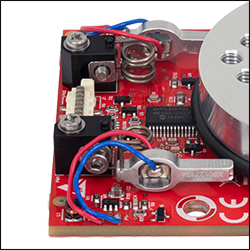
Click to Enlarge
The motors' aluminum tips contact the black plastic track encircling the rotation stage. This track should not be touched to prevent debris and oil building up on the track.
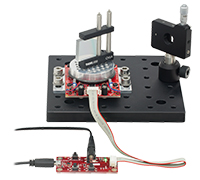
Click to Enlarge
ELL18K/M Rotation Stage Bundle used to Orient a Grating With Respect to a Variable Slit
- Ideal for OEM Evaluation Testing
- Easily Integrate into a Setup
- Operate using Manual and/or Computer Control
- Included Power Supply is Required for Powering the Stage
The Rotation Stage Bundle is a complete package that includes the ELL18/M rotation stage. The ELL18K/M package facilitates quick integration of the rotation stage into laboratory setups and other experimental applications. It also provides a convenient means to evaluate incorporating this technology into OEM applications.
The tips of both motor housings are in firm contact with the plastic track encircling the rotation stage, as can be seen in the image at the far-right. The motors are installed with opposite orientations and clockwise (and counterclockwise) rotation occurs when one motor pushes the track forward while the other pulls it backward.
| Included in the ELL18K(/M) Bundle | |
|---|---|
| ELL18/M Rotation Stage | 5 V Power Supply with Region-Specific Power Adapter |
| Interface Board | 8-Conductor 28 AWG Ribbon Cable and USB Cable |
| Mounting Brackets | PC-Based Software for Download |

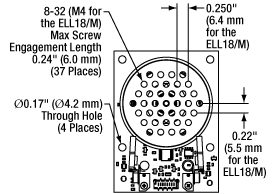
Click to Enlarge
Features of the Rotation Stage
This Rotation Stage is offered to meet the needs of applications whose designs require multiple networked Elliptec® resonant motor products. It possesses a Ø1.97" (Ø50.0 mm) top surface functionalized with 37 tapped 8-32 (M4) mounting holes with 6 mm deep threads. Details describing the dimensions, including the spacing of the threaded holes, and other specifications of the stage are given in the Specs tab. Please contact us to discuss customizing the rotation stage, or to arrange to purchase mounting brackets with the stage.
The PCB of the rotation stage incorporates a male 8-pin Picoflex® connector (header). Each ELL18(/M) stage ships with the female 8-pin Picoflex® connector (receptacle) that mates with the connector (header) on the board.

| Specifications | ||
|---|---|---|
| Item # | ELLC2 | |
| DC Voltage Input to Controller | 4.5 to 5.5 V | |
| Typical Current Consumption Per Module | Movement | 800 mA |
| Standby | 50 mA | |
| Operating Temperature Range | 15 to 40 °C | |
| Ribbon Cable Length (1 Included) | 250 mm (9.84") | |
| Maximum Supported Ribbon Cable Length |
500 mm (19.68") | |
| Dimensions (Interface Only) | 66.0 mm x 32.0 mm x 12.5 mm (2.60" x 1.26" x 0.49") |
|
| Weight (Interface Only) | 10.8 g (0.022 lbs) | |
- Convert Any Single ELL Device into a Kit by Adding the Following:
- Handheld Controller
- USB Micro B Cable
- Picoflex®1 Cable
- 5 V Power Supply with Regional Adapter (US, UK, AU, or EU)
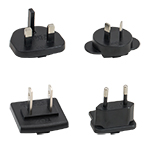
Click for Details
Region-Specific Adapters for the ELLC2 Power Adapter
Thorlabs' ELLC2 Accessory Upgrade Pack is designed to include all of the items necessary to convert any single ELL slider, stage, or mount into an ELL kit2. The included handheld controller features three buttons to control the position of a connected ELL stage and the USB port enables direct connection to a PC via the included USB Micro B cable. A 0.25 m Picoflex® cable with 8 loaded circuits that connects the handheld controller to the ELL device and a 5 V power supply with a regional adapter (US, UK, AU, or EU) are also included with the kit.
- Note: Picoflex® is a registered trandemark of Molex Incorporated.
- Mounting brackets for the ELL17(/M), ELL18(/M), and ELL20(/M) can be ordered by contacting Tech Support.

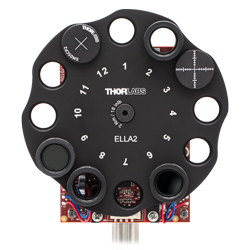
Click to Enlarge
The ELLA2 filter wheel adapter is shown with a balanced load mounted upright on the ELL18 rotation stage using the ELLA3 post mount adapter.
Please Note: Firmware v1.6 or higher is required to use the ELL18(/M) stage with the ELLA2 filter wheel.
- Holds up to 12 1/2" Optics, Unmounted or with SM05-Threaded Mounts
- Attaches Directly to ELL18(/M) Rotation Stage
The ELLA2 SM05-Threaded (0.535"-40) Filter Wheel Adapter attaches directly to the ELL18(/M) rotation stage and holds up to 12 Ø1/2" optics, unmounted or with SM05-threaded mounts. The filter wheel accommodates threads up to 5.5 mm deep. An unmounted Ø1/2" optic with a thickness ≤3.8 mm can be mounted using a single SM05RR retaining ring (sold separately).
The angular distance between adjacent SM05-threaded holes is 30°, and the maximum additional load that can be added to the filter wheel is 80 g. The load should not have an imbalance of more than 11 g. To achieve this, a filter in one hole should be balanced by a weight 180° around the filter wheel. For example, a neutral density filter with a mass of ~3.3 g could be balanced with a 3 g SM05CP2 end cap. For very light filters, tape could be used to balance the load. The image at the far right shows four SM05-threaded ND filters installed in the filter wheel, along with an SM05CP2 end cap for load balancing, and an SM05A7 alignment disk.
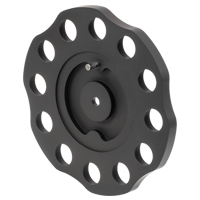
Click to Enlarge
Back Side of ELLA2 Filter Wheel Showing Features that Connect to ELL18(/M) Rotation Stage
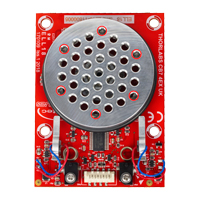
Click to Enlarge
The silver pin on the backside of the ELLA2 filter wheel fits into one of the six outermost threaded holes of the ELL18(/M) rotation stage, circled in red above.
The ELLA2 filter wheel has a silver pin on its back side, aligned with the position 1 on the front side, shown figure below on the far right. To mount the filter wheel onto the ELL18(/M) rotation stage, first align this silver pin with one of the six outermost threaded holes (6 x 60°) on the stage, circled in red in the figure below in the center. Before mounting the ELLA2 filter wheel, it is recommended to first home the ELL18(/M) stage to check which position offers the best fit (lowest offset). The recessed circle outside the silver pin on the filter wheel then snaps onto the outer contour of the silver moving circle of the rotation stage. Finally, secure the filter wheel to the rotation stage with the included 8-32 (M4) screw using a 3/32" (2.5 mm) hex key. Torque the 8-32 (M4) countersunk screw to 18 lb•in (2 N•m).
The ELLO GUI software, available for download from the Software tab above, can be used to control the filter wheel rotation. Note that the rotation stage must be using firmware version 1.6 or higher to support the ELLA2 filter wheel. More information on finding the firmware version, homing the device and optimizing operation of the ELL18(/M) stage for the filter wheel can be found in the ELL18(/M) manual. If a firmware update is required, please contact Tech Support.
| ELLA2 Filter Wheel Specifications | |
|---|---|
| Number of SM05 (0.535"-40) Internal Threads | 12 |
| Angular Distance to Adjacent Internally SM05-Threaded Hole | 30° |
| Maximum Unbalanced Loada | 11 g |
| Total Load (Balanced) | 80 g |
| Expected Positioning Speed Lossb | -30% |
| Dimensionsc | Ø94.0 mm x 6.0 mm (Ø3.70" x 0.24") |
| Weight | 70 g |

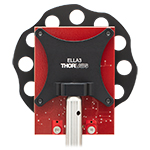
Click to Enlarge
ELLA3 Post Mount Adapter Application Example
- Four M4-Threaded Through Holes for Mounting to Rotation Stage PCB
- One Counterbore for Use with 8-32 (M4) Threaded Screw for Post Mounting
The ELLA3 Post Mount Adapter securely fastens to the back of the ELL18(/M) Rotation Stage PCB using the four included M4 screws. The rotation stage can then be mounted to a Ø1/2" post using the counterbore at the base of the adapter and an 8-32 (M4) screw (not included). This adapter allows the ELL18(/M) rotation stage to be mounted upright for applications requiring this geometry, such as for use with the ELLA2 filter wheel.

| Specifications | ||
|---|---|---|
| Item # | ELLB | |
| Voltage Rating | 4.5 to 5.5 V | |
| Typical Current Consumption Per Module | Movement | 800 mA |
| Standby | 50 mA | |
| Maximum Board Current | 4.0 A | |
| Operating Temperature Range | 15 to 40 °C | |
| Ribbon Cable Length (4 Included) | 250 mm | |
| Maximum Supported Ribbon Cable Length |
500 mm | |
| Dimensions | 65.0 mm x 32.0 mm x 12.5 mm (2.56" x 1.26" x 0.49") |
|
| Weight | 11 g (0.02 lbs) | |
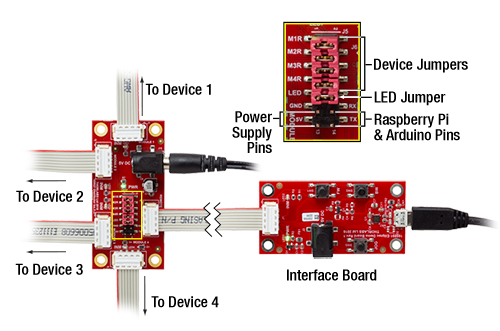
Click to Enlarge
A single bus distributor can be used to control up to four Elliptec devices. The bus can be connected to a PC using the interface board provided with the bundles sold above. Note that the bus is then controlled by the Elliptec software and that the buttons on the interface board are disabled.
- Control and Power up to Four Elliptec® Devices with One Bus
- Daisy Chain Bus Boards to Control up to 16 Elliptec Devices
- Controlled Remotely Using Elliptec System Software (See Software Tab Above)
- Connect to PC Using USB Interface Board Included with Elliptec Bundles
- Five Jumpers and Four 8-Conductor 28 AWG Ribbon Cables Included
- Compatible with Raspberry Pi® and Arduino® Boards
The ELLB Bus Distributor connects up to four Elliptec® devices. Connected devices can be controlled with or without the interface board included with the above bundles. When using the interface board, each connected device is controlled remotely by a PC running the Elliptec software package. The interface board connects to the bus's input port labeled REMOTE; once connected, the interface board's buttons are disabled. For control without using the interface board, see the Pin Diagrams tab for custom connections.
Multiple ELLB Bus Distributors can be daisy chained to control and power up to 16 Elliptec devices; simply connect one of the four MODULE outputs to the second board's REMOTE input. Indicator LEDs are provided to show which device is active. The communications protocol manual describes how to use the software to individually address each connected device. A link to download the software and accompanying documentation can be found in the Software tab.
The bus includes a Ø6.3 mm power connector that supports a 5 V supply with a maximum current of 4 A. As more devices are connected, simultaneous control of the units will require more current to be provided by the power supply; please see the Specs tab for the amount of current drawn by each Ellitpec device. A 5 V, 1 A power supply is included with the above ELL9 and ELL12 bundles. Depending on the current draw of the Elliptec devices connected, this supply provides enough current to power two devices simultaneously.
Fourteen control pins, detailed in the image to the right, are included for additional functionality. Four pairs of pins are each shorted with a jumper that, when in place, enables the Elliptec software to receive feedback from connected Elliptec devices. The pair of pins labeled LED is shorted with a jumper that, when removed, will disable the indicator LEDs. The 5V and GND allow an optional, user-provided 5 V, 2 A power supply to be used in place of a source connected to the Ø6.3 mm power connector. The RX and TX pins can be used to control the bus with a Raspberry Pi® or Arduino® board, respectively, instead of the Elliptec interface board.
The board is mounted using the Ø3.5 mm through holes provided in each corner. Four 8-conductor, 28 AWG ribbon cables are included.
| Compatible Elliptec Devices | |||||
|---|---|---|---|---|---|
 |
 |
 |
 |
 |
 |
| Multi-Position Sliders | 28 mm Linear Stage | 60 mm Linear Stage | Rotation Stage | Rotation Mount | Motorized Iris |
 Products Home
Products Home


















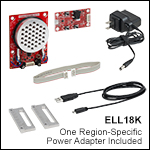
 Zoom
Zoom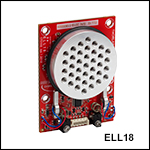
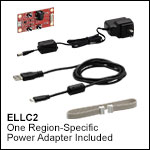
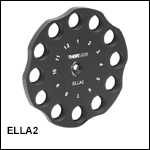
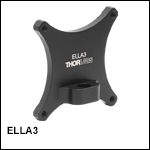
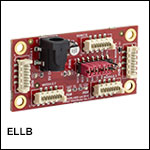
 Rotation Stage: Resonant Motor Driven
Rotation Stage: Resonant Motor Driven